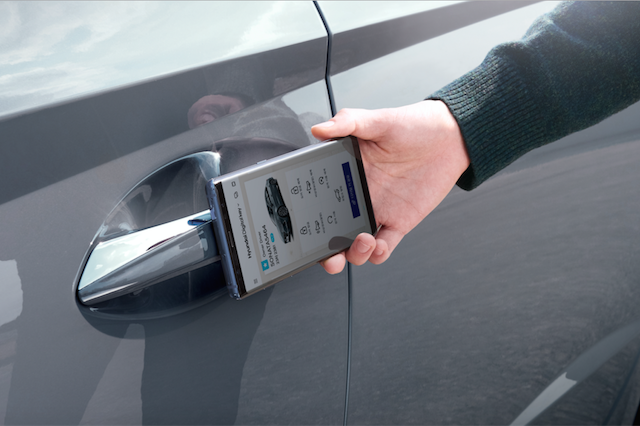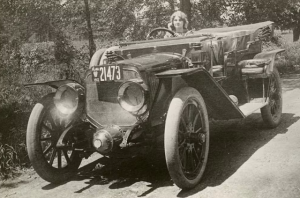What connotations come to mind with the words “car keys?” Bad thoughts, like frantically ransacking your house, bags and pockets in search of them? Good thoughts, like being handed them for the first time at a dealership or flicking your wrist and hearing the engine come alive?
Either way, these experiences are likely to soon be stowed-away memories of a different time: The truth is, the history of car keys as we know them is quickly coming to a close.
Just about every other aspect of automotive technology has drastically evolved over the past century, and the keys we use to open and start our cars are no different. But car key history is unique in that instead of simply improving the feature, current technology has rendered traditional car keys obsolete, sending them the way of the dodo, car ashtrays and crank windows.
That renders the age-old question: How did we get here? Let’s take a look back.

The History of Car Keys Begins
Car key history can be traced back to 1910, but these early versions didn’t start the engine or ignition. Instead, the first car keys controlled the ignition’s electrical circuit. Using the key, car owners could switch off the flow of electrical current, making it impossible to start the vehicle. Once the switch was on, the ignition could be activated, although drivers still had to then crank up the engine.
Soon after, keys that could lock and unlock both the electrical circuit and the ignition became more common.
Because it was still impossible to start the engine without a key, car theft was not a concern, and “locking” a car wasn’t a practice. In fact, most early automobiles were roofless and some were even door-less.
Mid-Century Car Keys
A major milestone in car key history occurred in 1949 when Chrysler unveiled the first car key that could start a vehicle’s engine all on its own. It was able to do so through the use of an ignition tumbler, or ignition lock cylinder.
In 1965, Ford became the first manufacturer to introduce double-sided keys that could be inserted into the tumbler either way. While seemingly elementary by today’s standards, these types of car keys remained the norm for decades.
This was also around the same the time the dual key, which could both start the car and unlock the doors, took hold. Prior to the 1960s, some vehicles still required two separate car keys.

Car Keys Meet Technology
Car key evolution was mostly dormant for the next quarter century but took some momentous leaps in the 1990s. It was this decade that saw the rise of the now ubiquitous key fob.
Remote keyless entry fobs allowed car owners to lock and unlock vehicle doors from afar by emitting a coded signal through radio waves to a receiver in the car. As technology developed, key fobs gained more functions, such as opening the trunk or sliding doors and starting the engine remotely.
(If you’re curious about the strange name, according to The Atlantic, “fob” may come from the word “fuppe,” which means “pocket” in the low German dialect.)
Car fobs are very expensive to replace. Make sure you’re protected with AAA’s Tire & Wheel Program, which covers lost keys and key fobs up to $5,000.

Car Keys Today
The traditional, mechanical car key is quickly becoming a thing of the past – if it’s not already a relic of automotive history. Almost all of today’s new vehicles have some version of a keyless entry and push-button start system. In fact, according to consumer auto research firm Edmunds, 91% of 2019 model-year vehicles had keyless ignitions. That’s up from 72% in 2014.
We’ve come a long way from having to carry one key for the engine and one key for the doors. But apparently one key is still one too many: Drivers can now store a digital car key on – where else – their phones.

Apple’s Wallet app includes a feature to add your car key. In order to do this, you need to have a compatible car as well as an iPhone or Apple Watch. Once installed, a user simply places their phone or watch next to the car’s door handle to unlock the vehicle. To start the car, they just place the phone or watch in the car’s key reader and press the start button. When an owner wants to share their key, they can simply send an iMessage to that user, which tells them how to add and use the car key.
Tesla owners can use the company’s smartphone app to do many of the same things. The app can track a driver’s smartphone from up to 30 feet away and automatically unlock the doors by the time they reach the car. But the electric automaker isn’t alone. About 31 brand marques, including BMW, Chevrolet, Chrysler, Dodge, Hyundai and Lincoln offer digital car keys, making the trend’s rise seem more assured and imminent.
What are your thoughts on car keys today? Do you like the idea of a digital key on your phone or would rather have a tangible key you can hold? Let us know in the comments below?
For more automotive history, visit AAA.com.
109 Thoughts on “The History of Car Keys”
Leave A Comment
Comments are subject to moderation and may or may not be published at the editor’s discretion. Only comments that are relevant to the article and add value to the Your AAA community will be considered. Comments may be edited for clarity and length.

















A thin key is best, IMO.
But keys aren’t simple anymore. You need to make sure that the copy of your key STARTS your car and does more than OPEN your vehicle.
To save money, car manufacturers have slowly removed locks around the vehicle: first the trunk, then the passenger door and now the driver door. If your driver door has ever been blocked by someone with poor driving skills (or are just plain inconsiderate), access via another method is necessary. Sure a key fob helps but as others have said those are large, somewhat clunky, subject to damage (especially water), and expensive to replace.
Though I prefer keys but we have one vehicle with an additional keypad entry and I’ll admit it’s nice to NOT carry a key when out hiking if I get back to the car before my husband. But that’s one of four vehicles we own. I can’t imagine memorizing codes for each vehicle. Setting all of them to the same number? That’s fine except when a factory reset happens and your code reverts to the manufacturer’s setting.
Spare keys (without fobs) tend to be slim, lightweight and can fit into a wallet slot or other tiny space. When I run or might be taking a swim, key fobs are a problem. Tying a key & fob to my shoe are an option and painful if I take a long run due to the constant pounding against my foot. Swimming? The only option is a metal key or a vehicle with keyless entry.
The thought of using my phone? Dead battery or phone? How do I access? The dead battery is a reality and I don’t want to take my phone along on my run or swim.
I hope the auto industry listens. Everyone I know prefers a KEY. Also please keep costs down with this simple device.
Things haven’t really changed all that much; you still have to find your “key fob” if you want to go anywhere and the fob for my car has a removable key incase the battery in the fob is dead or it just isn’t working. So you still need an object in your pocket to operate your car and for men, some of the key fobs are pretty large to carry around in your pants pocket.
I own a classic 1966 Chevy Impala, it has two keys, one for the ignition and one for the doors and trunk and they are tiny compared to later car keys, now they would be easy to lose!
I prefer a key.
When I go swimming at the beach or pool, I take the metal key out of the fob and lock the fob in the car. Then I can tie the key to the string in my swimsuit waist band so I don’t lose it in the pool or beach. I can’t swim with the fob and don’t want to leave it on the beach with my shirt and shorts where it could be stolen. If the fob didn’t have a metal key inside, I don’t know what I would do!
when the car battery is low you can;t open the car doors with the fob you have to use the key on the fob to open the door I found that out there is a whole in the door handle you stick the key in the whole and pull off the small part of the latch and stick in the key & turn it
Digital starters also create issues with car theft. Thieves have a way of cracking the code and of not just the garage door opener, but the car’s key code. Police recommend keeping key fobs in a special box that the digital readers can’t penetrate.
I agree in general with the complaints about technology and hate the idea of moving the “key” to cell phones, but I’m surprised that no one has said that every keyless start car has a backup method to start the car even if the key fob battery has died. And only the new Mustang Mach E does not offer a backup to get inside other than the phone app. Otherwise, as many noted, nearly every key fob has a mechanical key in it that will unlock the driver’s door. Tesla uses a placement method to open. The key fob needs to be held near a detector on the body of the car (and it works!).
These comments. Wow. I’m an early adopter of technology and drive an electric car with no key. My house has an electric lock on the front door. Freedom baby! No keys at all!
First comment I can say “agreed”.
I don’t want anything that has to do with a smartphone. Keys please!
As with most new “tek no logicgy”, whenever you see the phrase “new and improved” somehow expect to be getting screwed.
Next time someone changes your light bulb make sure they are wearing gloves. Any light oil film from your fingers will reflect the light within, raising the temperature and drastically reduce the life of the bulb